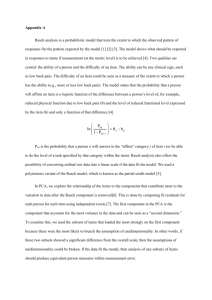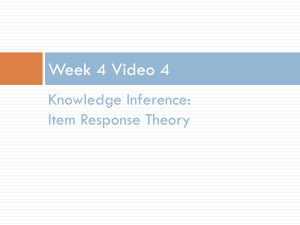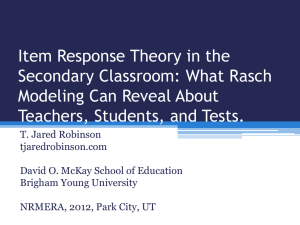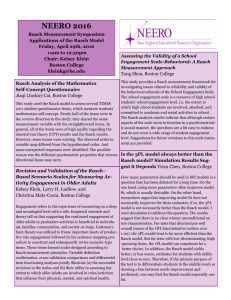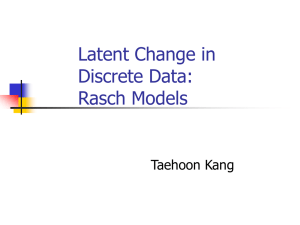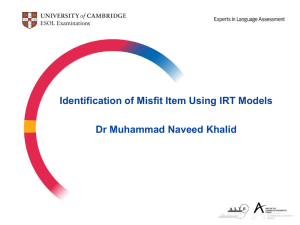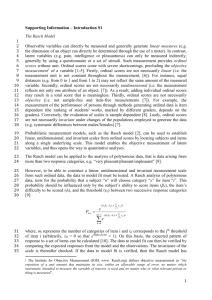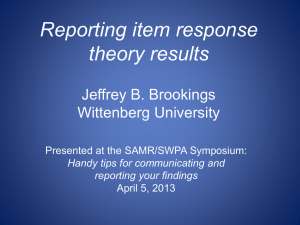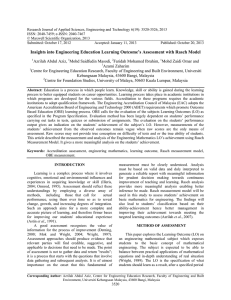Intro to Item Response Theory
advertisement
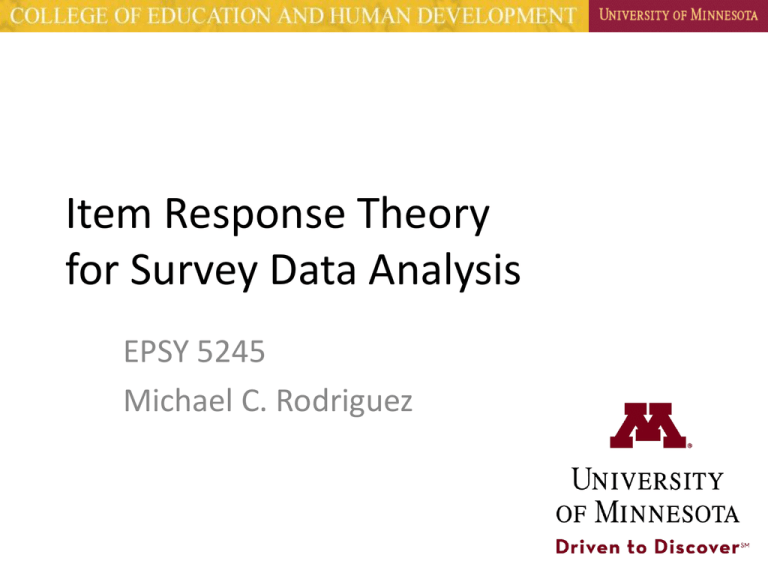
Item Response Theory for Survey Data Analysis EPSY 5245 Michael C. Rodriguez Wilson, M. (2005). Constructing measures: An item response modeling approach. Mahwah, NJ: Lawrence Erlbaum. Reeve, B.B., & Mâsse, L.C. (2004). Item response theory modeling for questionnaire evaluation. ADDITIONAL READINGS & ONLINE RESOURCES • IRT Resources Online • Introduction to IRT by Zickar online • Hambleton, R. K., & Jones, R. W. (1993). An NCME instructional module on : Comparison of classical test theory and item response theory and their applications to test development. Educational Measurement: Issues and Practice, 12(3). 38-47. One Approach – Construct Map • Construct Definition (measuring a trait) – A simple form: More or less, high to low • Item Development – Realizations of the construct • Outcome Space – Aspect of response we value – how to score • Measurement Model – How we relate scores to constructs From Construct to Item Responses Causality Construct Measurement Model Item Responses Outcome Space Inferences Source: Mark Wilson, 2005 Background to IRT • IRT is a way of thinking about measurement: a probabilistic model. • We give an item or task to a person and obtain an “item-person” interaction. • This results in a score with a probability, given a person’s ability. • Ability scores are more fundamental because they are test independent. • Examinees come to a test administration with trait levels in relation to the construct being measured – not necessarily in relation to the test being administered. • Each child has a trait score that is defined in relation to the construct at the time of an assessment, and this remains invariant over samples of assessment tasks. • Their trait score is not a function of what tasks they perform – their performance on the tasks is a function of their ability. Measurement Models: IRT v. Rasch • Most IRT models are based on a paradigm that identifies a model which explains variation in the data – to find a model that best characterizes the data. • Rasch is an approach that is based on the paradigm of constructing a measure which can characterize a construct on a linear scale – such that the total score fully characterizes a person on a given construct. Rasch Philosophy • Rasch models provide a basis and justification for obtaining person locations on a continuum from total scores on assessments. • Although it is not uncommon to treat total scores directly as measurements, they are actually counts of discrete observations rather than measurements. • Each observation represents the observable outcome of a comparison between a person and item. • Such outcomes are directly analogous to the observation of the rotation of a balance scale in one direction or another. • This observation would indicate that one or other object has a greater mass, but counts of such observations cannot be treated directly as measurements. Item Characteristic Curve Test Characteristic Curve Test Characteristic Curve 4 Points on the Raw Score Scale Test Characteristic Curve 4 Points on the Raw Score Scale 0.5 on the Rasch Scale Test Characteristic Curve 4 Points on the Raw Score Scale 0.5 on the Rasch Scale 4 Points on the Raw Score Scale Test Characteristic Curve 4 Points on the Raw Score Scale 0.5 on the Rasch Scale 4 Points on the Raw Score Scale 1.2 Point on the Rasch Scale From Numbers to Meaning • Numbers themselves do not mean much. – Is 10 meters a short distance? Long distance? We need context to bring meaning to the measure: 10 meters. However, 10 meters should always be 10 meters, no matter who takes the measure or how it is taken. Sample Dependent Statistics • Is an item with a p-value of .90 easy or difficult? … 90% passed the item • Is a person with a score of 5 out of 50 items low in ability? … correctly answered 10% of the items IRT Scaling • Person-free item difficult – Locates the items on the ability continuum • Item-free person ability – Locates the person on the ability continuum • Places items and persons on the same scale – the ITEM MAP Item Map Construct MAP 1. Explains the construct; interpretation guide 2. Enables design of items that will lead individuals to give responses that inform important levels of the construct map; identify relevant item features 3. Provides criterion to analyze responses regarding degree of consistency with intended construct 4. Item selection or retention should be based on informed professional judgment Construct Map Describing Task Characteristics IRT Assumptions • Local independence – Responses to differing items on the test are independent of one another, conditional on the trait they have in common (i.e., conditional on the latent trait items are uncorrelated). • Unidimensionality – Only one dominant trait is being measured. – Multidimensional models now exist. Validity Validity refers to the degree to which evidence and theory support the interpretations of test scores entailed by proposed uses of tests. Standards for Educational & Psychological Testing (AERA, APA, NCME, 1999) Validation Validation is the process of gathering evidence to achieve these goals, including evidence related to the – construct, – content, – response processes, – internal structure, – relations to other variables, and – the consequential bases of validity. Evidence In all cases, the most important sources of validity evidence are those that are most closely related the nature of the inferences we draw regarding scores. We can begin to secure evidence to support our intended inferences in the design of any test. OTL: Uses of Assessment &INST TITLE = OTL Math Education Assessment Uses DATA = merged.dat NAME1 = 1 NAMELEN = 29 ITEM1 = 30 NI = 136 IDFILE =* +67-68 +73-75 * CODES = 1234 MODELS = R GROUPS = 0 &END Response Data 72 10110101 1212221121122212211211211221221111121234323331 12233442211134443434342322343443221111111332242 23321123344424241323231121399999999999999999 72 10110102 1211121221121212111111111221121111121132332134 44114323232222343333344343244434421111111444333 44443223332234341424444443444413444411334444 72 10110103 1212229221122222211211221221221111122142311131 23112344132343112444122224334434421211221133344 34333123231224241422334224433124443213113334 Run Analysis… Beliefs: Quality of Instruction &INST TITLE = Program as a whole: program effectiveness DATA = merged2.dat NAME1 = 1 NAMELEN = 16 ITEM1 = 17 NI = 53 IDFILE =* +48-53 * CODES = 123456 MODELS = R GROUPS = 0 &END Response Data 72 10110101 1554465453524352112232224334442 65624342134333344443445 72 10110102 1666646466666452142562455555331 44654444344444444666666 72 10110103 1546655365664522413562116664134 14614342134434343244545 Run Analysis… Evaluate the functioning of scale properties • We can ask questions about the response scale: Does the 5-point scale work as interpreted? Do we need 5 points? 35 Minnesota Student Survey Mental Distress Mental Distress Item During the last 30 days, have you felt you were under any stress or pressure? o Yes, almost more than I could take o Yes, quite a bit of pressure o Yes, more than usual o Yes, a little o No 37 38 Mental Distress Item During the last 30 days, have you felt sad? o All the time o Most of the time o Some of the time o A little of the time o None of the time 39 40 Item Map - Thresholds Rasch Logit Scale 2 . .# .# . .## .# .# 1 0 + | | | | | | .# + .#### .## .##### .### .####### .### | | | | | | .######## +M U49hr.45 U49br.45 U50r .45 U51r .35 U49dr.45 U49fr.45 U52r .35 U53r .35 U49hr.35 U52r .25 U49br.35 U50r .35 41 Other Possible Analysis • Differential Item Functioning – Group difference, conditioned on trait level – Form of measurement invariance; item bias • Equating over time – Constant score scale location over time – Keep item parameters and fix item locations – Examine parameter drift over time 42 Returning to TIMSS Liking Math… Mean = 2.45 Rasch = 0.40 Mean = 2.46 Rasch = 0.60 43 Ordering of Items by… Item Mean Rasch location Math is important Enjoy learning math Like math Math is easy Like a job involving math Math is boring Math is important Enjoy learning math Like math Math is boring Math is easy Like a job involving math 44 | | . T+ | .### | .##### | S| .####### |T 1 . + . | .######### | .############ | Easy .35 Boring .35 Job .35 2 0 -1 Boring .25 Easy .25 Job .25 .########## | . +M .####### | .##### S| . | .### |S .## | . + .# T|T Job .15 . | | Boring .15 Easy .15 EASY BORING JOB BORING EASY JOB JOB BORING EASY 45
